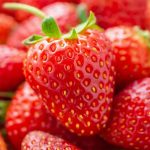 In the Middle Ages, women stopped eating strawberries while they were pregnant because they feared that the berry would cause their child to be born with red birthmarks; a blemish still known as a strawberry mark. The word strawberry, however, is as innocuous as it sounds, deriving simply from straw—the hollow, dried stems of certain grains—and berry. This berry came to be associated with straw perhaps because gardeners have long spread chopped straw around the roots of the strawberry plant to protect them; alternatively, the long runners of the plant, after they die and dry out, may have been thought to resemble grain straw. A third possibility lies in the origin of straw itself: straw takes its name from being the part of the grain that gets strewn on the floor; likewise, the wandering runners of a strawberry plant appear to be strewn all over the garden, meaning that the strawberry might literally be a strew-berry. The English word stray derives from the same source as strew and straw, and so does the baking term streusel, the name of a crumblike topping strewn onto the tops of cakes and pastries. Of these words, streusel is the most recent addition to English, having been adopted from German at the beginning of the twentieth century. Much older are straw and strawberry: both are first recorded in English about a thousand years ago, although straw did not acquire its sense of a tube to drink through until the mid nineteenth century. The verb strew, the oldest of these words, is first recorded in the late tenth century.
In the Middle Ages, women stopped eating strawberries while they were pregnant because they feared that the berry would cause their child to be born with red birthmarks; a blemish still known as a strawberry mark. The word strawberry, however, is as innocuous as it sounds, deriving simply from straw—the hollow, dried stems of certain grains—and berry. This berry came to be associated with straw perhaps because gardeners have long spread chopped straw around the roots of the strawberry plant to protect them; alternatively, the long runners of the plant, after they die and dry out, may have been thought to resemble grain straw. A third possibility lies in the origin of straw itself: straw takes its name from being the part of the grain that gets strewn on the floor; likewise, the wandering runners of a strawberry plant appear to be strewn all over the garden, meaning that the strawberry might literally be a strew-berry. The English word stray derives from the same source as strew and straw, and so does the baking term streusel, the name of a crumblike topping strewn onto the tops of cakes and pastries. Of these words, streusel is the most recent addition to English, having been adopted from German at the beginning of the twentieth century. Much older are straw and strawberry: both are first recorded in English about a thousand years ago, although straw did not acquire its sense of a tube to drink through until the mid nineteenth century. The verb strew, the oldest of these words, is first recorded in the late tenth century.
In the vast tapestry of plant life, we encounter a humble and low-growing marvel, widely cultivated across the globe the strawberry. While the wild strawberry bears a delectable fruit, its dimensions pale in comparison to the cultivated varieties we have come to cherish. These succulent gems serve as a bountiful source of vitamin C, enriching our diets with their nutritive properties and offering a tantalizing burst of flavor.
